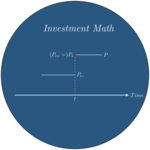From Gaussian to Ornstein Uhlenbeck Processes
This post introduces Gaussian processes, i.e. processes with Gaussian finite dimensional multivariate distributions. Amongst Gaussian processes, the Ornstein Uhlenbeck process is the only Markovian covariance stationary example. It plays a key role in applications thanks to its tractability.
Gaussian processes
Gaussian processes provide a very handy toolbox for modeling. A Gaussian process is a process \((X_{t})_{t \in \mathbb{T}}\) such that for any finite set of indices \((t_{1},t_{2},\ldots,t_{n})\), \((X_{t_{1}},X_{t_{2}}\ldots,X_{t_{n}})\) follows a multivariate Gaussian distribution. It should be reminded that the distribution of a random process, i.e. the distribution of the function \(\omega \mapsto (X_{t}(\omega))_{t \in \mathbb{T}}\) , is determined by its finite dimensional distributions., i.e. the set of distributions corresponding to the set of functions \(\omega \mapsto (X_{t_{1}}(\omega),X_{t_{2}}(\omega)\ldots,X_{t_{n}}(\omega))\) indexed by \(n-\)uples \((t_{1},t_{2},\ldots,t_{n})\).
A multivariate Gaussian distribution is characterized by its mean \({\boldsymbol \mu}\) (a vector) and its covariance matrix \({\boldsymbol \Sigma}\). All its other moments are a function of the first two moments.1
One can prove furthermore that the set of finite dimensional Gaussian distributions of a Gaussian process is characterized by the mean function \(t \mapsto E(X_{t})\) and the covariance function \((u,v) \mapsto Cov(X_{u},X_{v})\). Indeed, one can recover the finite dimensional means and covariances from these two functions.
Brownian stochastic integrals using deterministic integrands deliver continuous time Gaussian processes. Assume the function \(h(\cdot)\) on \([0,\infty[\) is square integrable when restricted to \([0,t]\) (\(\int_{0}^{t}|h(u)|^{2}du<+\infty\)). We can then define a continuous Gaussian process through varying the end point \(t\) of the stochastic integral:\[\int_{0}^{t}h(u)dW_{u}.\] This process is obviously centered (\(E[\int_{0}^{t}h(u)dW_{u}]=0\)). It is also Gaussian. When \(h\) is a step function, it is a simple weighted sum (with deterministic weights) of non overlapping (and thus independent) Brownian increments. A square integrable function can be approximated in the \(L^{2}\) sense by step functions \(h_{n}\) and it can be shown that the limiting operation preserves the Gaussian nature of the process2.
One can similarly define \(\int_{-\infty}^{t}h(u)dW_{u}\) provided \(\int_{-\infty}^{t}|h(u)|^{2}du < +\infty\).
Ornstein-Uhlenbeck
A process is stationary if the distribution of \((X_{t+t_{1}},X_{t+t_{2}}\ldots,X_{t+t_{n}})\) is independent of \(t\) for all choices of \(n\), \(t\) and \((t_{1},t_{2},\ldots,t_{n})\). Stationarity is invariance with respect to time translations. The covariance function \((u,v) \mapsto Cov(X_{u},X_{v})\) then only depends on \(v-u\). A process is Markovian if as of time \(s\), all information regarding the future trajectory of \(X\) is contained in the value \(X_{s}\). One does not need to know more than the current value of \(X\) to predict its future.
Markovianity and stationarity imply3 that \(cov(X_{s},X_{t})=a\exp(-b|t-s|)\) for positive constants \(a\) and \(b\). This is the covariance function of the Ornstein Uhlenbeck which can thus be described as the only stationary markovian Gaussian process out there.
We can express the Ornstein Uhlenbeck process as Brownian integral. To do so, we need recover this covariance function through a suitable choice of \(h\) in \(\int_{-\infty}^{t}h(t,u)dW_{u}\) using: \[cov(\int_{-\infty}^{s}h(s,u)dW_{u},\int_{-\infty}^{t}h(t,u)dW_{u})=\int_{-\infty}^{\min(s,t)}h(s,u)h(t,u)du.\] Choosing \(h(t,u)=\beta^{\frac{1}{2}}\exp(-\alpha (t-u))\) with both \(\beta\) and \(\alpha\) strictly positive, we get: \[\int_{-\infty}^{\min(s,t)}h(s,u)h(t,u)du=\frac{\beta}{2\alpha}\exp(-\alpha|t-s|).\]
We have thus defined a Gaussian stationary and markovian process through:\[X_{t}=\int_{-\infty}^{t}\beta^{\frac{1}{2}}\exp(-\alpha (t-u))dW_{u}.\] This is a moving average representation of the random variable \(X_{t}\), which has mean \(0\) and variance \(\beta/(2\alpha)\). From the moving average representation, it is easy to establish that for \(t \geq s\): \[X_{t}=\exp(-\alpha(t-s))X_{s}+\int_{s}^{t}\beta^{\frac{1}{2}}\exp(-\alpha (t-u))dW_{u}.\] We can condition the process on \(X_{0}=x\) in which case we have: \[X_{t}=\exp(-\alpha t)x+\int_{0}^{t} \beta^{\frac{1}{2}}\exp(-\alpha (t-u))dW_{u}.\] We can thus build a (non stationary) Ornstein Uhlenbeck process on \(\mathbb{R}_{+}\).
A useful martingale derived from \((X_{t})_{t \in \mathbb{r}_{+}}\) is \((\exp(\alpha t)X_{t})_{t \in \mathbb{r}_{+}}\). Indeed: \[\exp(\alpha t)X_{t}=X_{0}+\int_{0}^{t}\beta^{\frac{1}{2}}\exp(\alpha u)dW_{u}.\] In differential form, this gives: \[d(\exp(\alpha t)X_{t})=\beta^{\frac{1}{2}}\exp(\alpha t)dW_{t},\] or (ito): \[\exp(\alpha t)dX_{t}+\alpha \exp(\alpha t)X_{t}dt=\beta^{\frac{1}{2}}\exp(\alpha t)dW_{t},\] i.e.: \[dX_{t}=-\alpha X_{t}dt+\beta^{\frac{1}{2}}dW_{t},\] which is known as Langevin’s equation.
One can change the mean of the Ornstein Uhlenbeck process. An Ornstein Uhlenbeck process with mean \(\mu\) is obtained from \(X\) by setting \(Y_{t}=X_{t}+\mu\).
An Ornstein Uhlenbeck in one dimension is thus determined through three parameters with the following interpretations:
- \(\sigma=\beta^{\frac{1}{2}}\) is the volatility of the process; it describes the elasticity of \(X_{t}\) to the contemporaneous shock of the Brownian motion,
- \(\alpha\) is the speed of mean reversion of \((X_{t})_{t \in \mathbb{t}}\); \(\alpha\) determines how persistent an impact a given shock \(\beta^{\frac{1}{2}}dW_{u}\) has on the future trajectory of \((X_{t})_{t \in \mathbb{t}}\),
- \(\mu\) is the mean of \((X_{t})_{t \in \mathbb{t}}\).
Finally, the stationary distribution of an Ornstein Uhlenbeck process is \(N(\mu,(\beta/2\alpha )^{\frac{1}{2}})\)
To complete this introduction, let’s quote a relationship between the Ornstein Uhlenbeck process and time changed Brownian processes (see this post). To simplify the formulas, let’s assume \(\mu=0\). The case where \(\mu\) is different from \(0\) is then immediate. We saw that \((\exp(\alpha t)X_{t})_{t \in \mathbb{r}_{+}}\) is a continuous martingale that can thus be expressed as a time changed Brownian motion. To identify this time change, one starts from the idea that the time changed Brownian motion should have the same quadratic variation as the continuous martingale. We thus start by computing the latter: \[[\beta^{\frac{1}{2}}\int_{0}^{\cdot}\exp(\alpha u)dW_{u}]_{t}=\int_{0}^{t}\beta \exp(2\alpha u)du=\frac{\beta}{2\alpha} \int_{0}^{t}d(\exp(2\alpha u))=\] \[\frac{\beta}{2\alpha} \int_{0}^{\exp(2 \alpha t)}dv.\] We can thus find (see Kallenberg[2002], theorem 18.4) a new Brownian motion \((B_{t})_{t \in \mathbb{r}_{+}}\) initialized at \(0\) such that: \[\beta^{\frac{1}{2}}\int_{0}^{t}\exp(\alpha u)dW_{u}=(\frac{\beta}{2\alpha})^{1/2}\int_{0}^{\exp(2\alpha t)}dB_{v}=(\frac{\beta}{2\alpha})^{1/2}B(\exp(2\alpha t)).\] It thus turns out that: \[\exp(\alpha t)X_{t}=(\beta/2\alpha )^{\frac{1}{2}}B(\exp(2\alpha t)),\] or: \[X_{t}=(\beta/2\alpha )^{\frac{1}{2}}\exp(-\alpha t)B(\exp(2\alpha t)).\]
Note: This note owes a lot to Kallenberg[2002], chapter 13.
References: Kallenberg, O., 2002, Foundations of Modern Probability, Springer.
Links
As a reminder, its density function is: \[f({\boldsymbol x})=(2\pi)^{-n/2}\det(\boldsymbol{\Sigma})^{-1/2}\exp(-\frac{1}{2}(\boldsymbol{x-\mu})^{t}\boldsymbol{\Sigma}^{-1}(\boldsymbol{(x-\mu})),\] and its characteristic function is: \[E(\exp(i\boldsymbol{u^{t}X}))=\exp(i\boldsymbol{u^{t}\mu}-\frac{1}{2}\boldsymbol{u^{t}\Sigma u}).\]↩︎
This proof requires a few steps. It hinges crucially on the fact that for fixed \(t\), \(\int_{0}^{t}h_{n}(u)dW_{u}\) converges to a Gaussian variable as \(n\) tends to infinity. It also uses the fact that the process \((\int_{0}^{t}h(u)dW_{u})_{t \in \mathbb{T}}\) has independent increments - remember that for two non overlapping intervals \(Cov(\int_{I}h(u)dW_{u},\int_{J}h(u)dW_{u})=0\) which implies that both integrals are independent since they have Gaussian distributions.↩︎
See Kallenberg[2002], proposition \(13.7\) p. 254.↩︎
